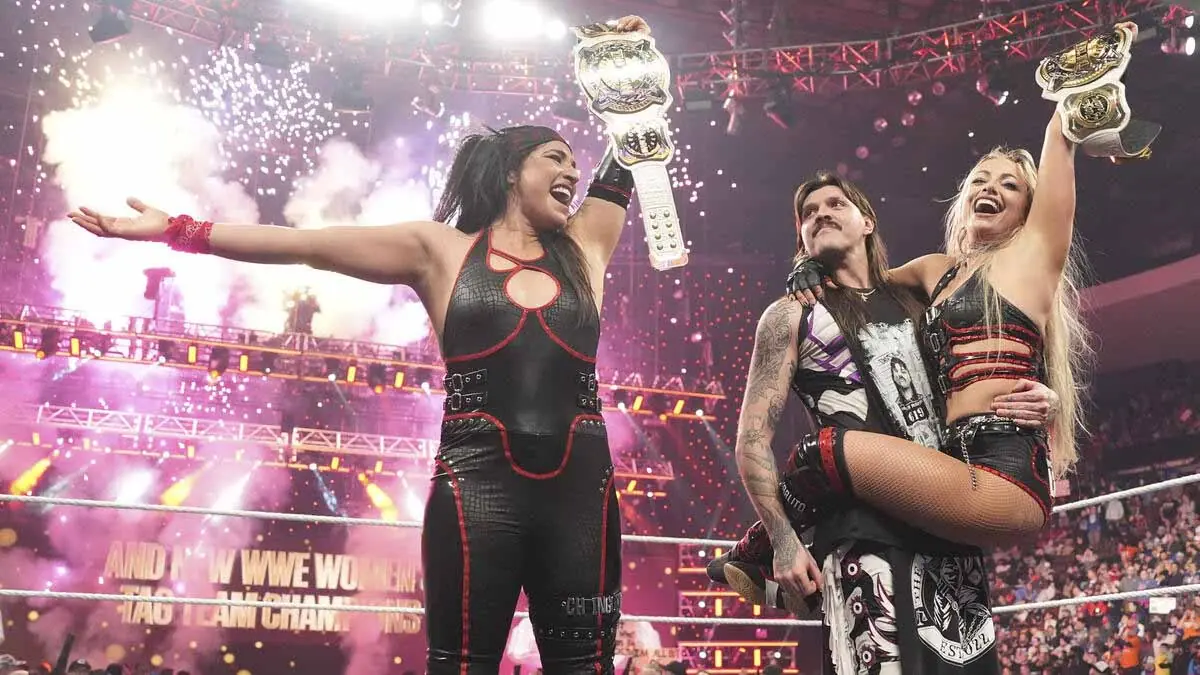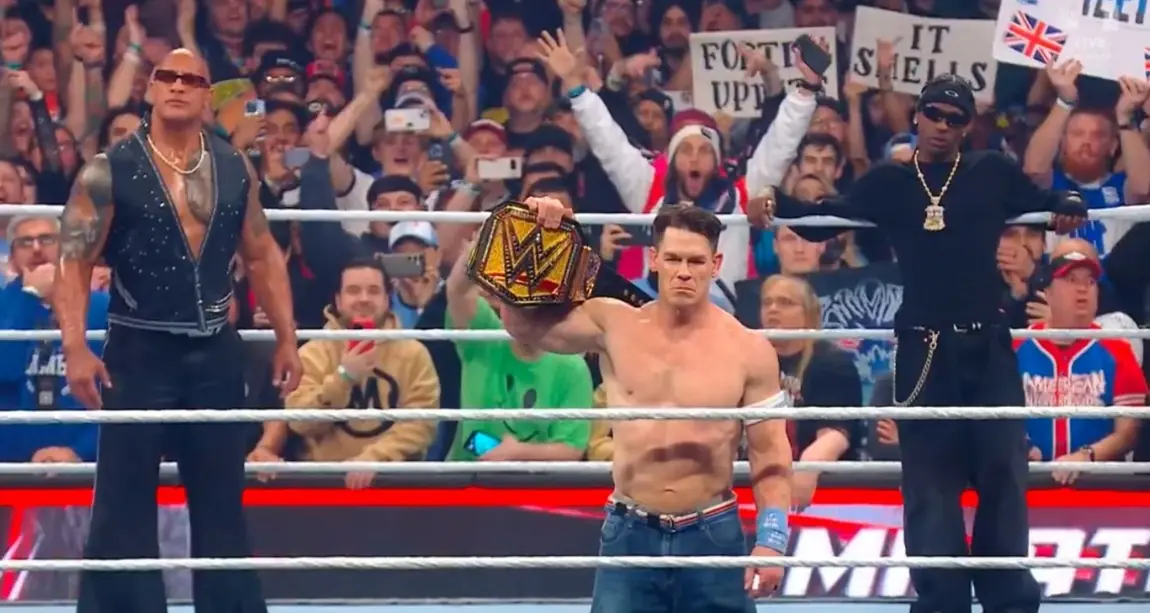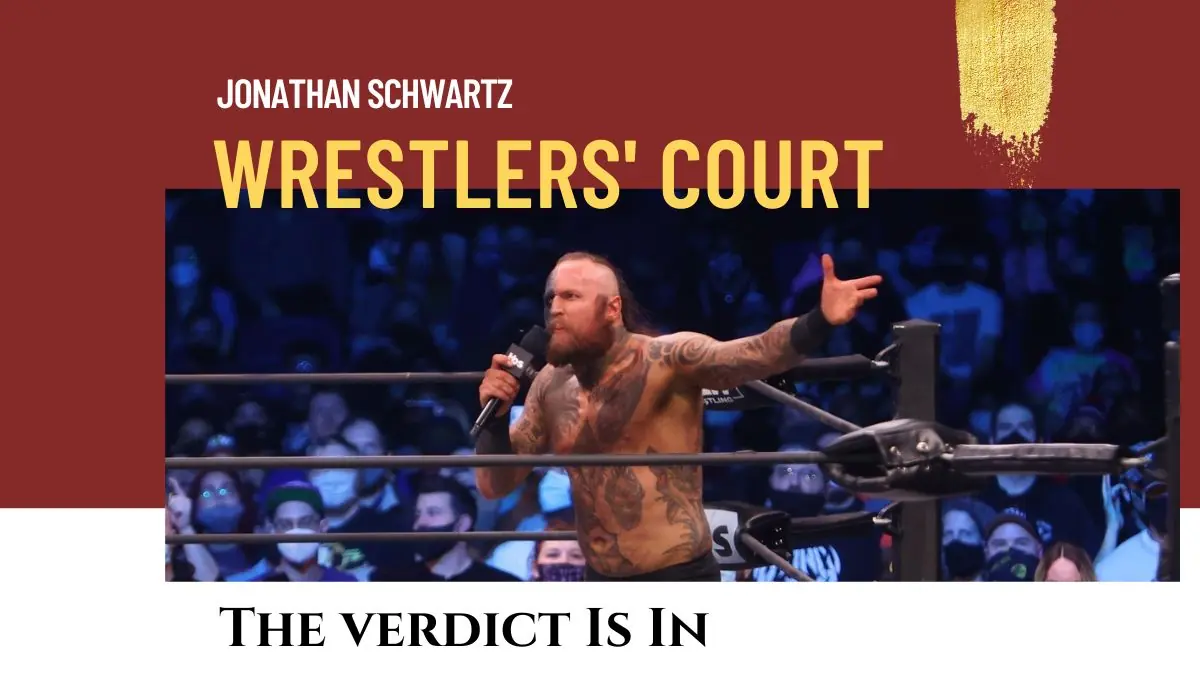The March 14 episode of WWE SmackDown emanated from Barcelona Spain, which is fitting since the tag team reign of #DIY Johnny Gargano and Tomasso Ciampa), which had mainly been plain, came to an end at the hands of the Street Profits-Angelow Dawkins and Montez Ford.
The Street Profits ended #DIY’s second tag team reign at a shade over 98 days; the latest in a series of relatively short title reigns following the epic runs of the New Day and the Usos. In fact, since the Usos’ 622 day reign end at WrestleMania 39, no team has held the tag team belts for as much as half a year, with nine reigns split between seven teams (the Judgment Day’s Finn Balor and Damien Priest, and #DIY have both held the titles twice, while teams like A-Town Down Under, The Motor City Machine Guns and The Bloodline have each claimed one reign each).
This is the first time the Street Profits have claimed tag team gold in over five years. Between 2019-2021 the Profits won the NXT, RAW and SmackDown champions, but were mostly mid-card fodder ever since. At one point, WWE teased breaking the team up, having the charismatic and acrobatic ford go it alone. This plan stalled out. So did an alliance with post-Hurt Business Bobby Lashley, who formed a new alliance called “The Pride” with the Profits-which was meant to turn the team heel, but given Lashley’s relative charisma deficit, turned them all babyface in time for a meaningless hardcore match against Karrion Kross’ Final Testament. Less than a year later, both factions are dead. Lashley’s doing better in AEW reunited with MVP and Shelton, and AOP have presumably started their next book tour.
The Street Profits seem to be turning heel; they’ve consistently attacked other SmackDown tag teams including Pretty Deadly, Los Garzas, MCMG and #DIY. SmackDown has always done a bit more shading in it’s character development, so while the Profits may be faces to relieve the current heel champs of their titles, I do think a full transition is imminent. After all, they wore solid black outfits to take the titles.
It would be easy to say that the title switch was intended to pop an international audience. WWE is currently touring Europe. As international access to their product has improved between the current Netflix deal and a more robust international touring schedule, it makes sense that WWE would want to give its European fans something to talk about. Gone are the days when a wrestling-desperate continent would soak up whatever third-rate matches WWE sent over (I still remember reading an old issue of WWF Magazine which hyped pre-Young Stallions Paul Roma and S.D. Jones as a top tag team in advance of an international tour). Globally, wrestling fans are sophisticated and demand their share of the action. Not only do they have better access to the WWE product, plenty of current WWE stars had full careers abroad before moving to the US. Hometown fans are hometown fans wherever you go. They want to see themselves represented as much as any American of Canadian fan.
That said I think this flurry of title changes on the eve of WrestleMania means a bit more than a cheap pop.
I suspect this shift to shorter reigns is meant to shore up fans’ perception of WWE’s mid card-in this case the tag team division, which was often neglected under the previous creative regime. Hopscotching title belts may help create the impression that the division as a whole is strong-and after years of neglect featuring a limited number of players, I tend to agree. One may argue that MCMG were pushed to the titles a bit too quickly; that this was a win for ‘smart fans’ who were familiar with the team from the independent scene and TNA. One could also note that despite some absolutely fabulous in-ring work, MCMG and #DIY haven’t elicited the kind of audience reactions that one might hope for. Personally, I would still like to see a longer, more dominant run for whatever version of the Bloodline they feed us next. WWE’s abortive runs with Karl Anderson and Luke Gallows shows it’s struggles in booking what should be surefire hits coming from overseas.
I like it when the title picture gets shaken up and more teams feel competitive. It reminds me of the days before kayfabe was openly disregarded, and the same “on any given Sunday” ethos applied to pro wrestling as it did most ‘legitimate’ sports.
I’m more interested in the timing and frequency of these flash title changes.
WWE has switched four of its main roster titles in recent weeks (six, if you count Stephanie Vaquer winning the NXT women’s title and Shawn Spears defeating Tony D’Angelo for their North American championship).
On February 24, Liv Morgan and Raquel Rodriguez defeated Naomi and Bianca Belair for the all-brand women’s tag team championship-which made sense as a way to transition Belair to a match against Ripley at WrestleMania (more on that shortly) and Cargill to a program with an experienced worker in Naomi. Only Iyo Sky beat Rhea Ripley for the championship on March 3. Nothing against Sky, who had a good match as champion in an emotional program with Bayley at last year’s WrestleMania, but fans have been clamoring for a match between Belair and Ripley-two fantastic, charismatic athletes in the prime of their career. I’m more interested in that matchup than the tile between Tiffany Stratton and Charlotte Flair-who by rights should ‘make’ the younger champion, but seems more likely to derail her momentum.
Meanwhile, on the men’s side LA Knight beat Shinsuke Nakamura to take his United States title back on March 7. This title switch was initially believed to reflect WWE’s waning confidence in Nakamura-whom they claimed would be leaving the fed imminently. WWE has since rejected these claims. The Street Profits’ win followed just this past Friday.
WrestleMania 41 is set for April 19-20. With less than a month to showtime, WWE has shaken up it’s midcard scene.
It’s a significant shift in WWE’s storytelling philosophy, which had fixated on longer title reigns over the last few years. Not quite the blink-and-you’ll-miss-them runs we saw during the Attitude Era, but fast enough that a month’s vacation from watching wrestling could mean coming back to new champions.
On balance, that’s a good thing-even as it emphasizes the foolhardiness of record-keeping in pro wrestling.
WWE has long been an outlier in how it books its’ titles. Strong babyface champions enjoyed years-long runs, while tag team (and eventually Intercontinental championship) reigns were often measured in months. Of course, this magnified the audience’s reaction when a hero was finally defeated (Madison Square Garden went silent when Bruno Sammartino lost to Ivan Koloff after seven years as champion) or when a villain got his comeuppance (The Ultimate Warrior’s rocket push to WWE’s main event started when he destroyed the Honky Tonk Man at the first SummerSlam).
Title reigns meant even more because there were so few belts to go around. In WWE new belts (like a “martial arts”, junior heavyweight or women’s tag team) might be introduced occasionally to bolster relationships with overseas promotions or spotlight particular feuds, but the title scene was relatively static. Over the years WWE has retired a bunch of belts-including those of other promotions’ it’s acquired, multiple attempts to expand into different weight classes, and storyline titles like the Million Dollar, Hardcore or 24/7 championships that just outlived their usefulness. Still, until the mid-90s or so, every wrestler on the card was presented as chasing after one of four titles: World Heavyweight, Intercontinental, Tag Team or Women’s (as applicable). With so many wrestlers vying after so few prizes and a push towards more dramatic storytelling that featured heroes chasing after villainous champions, it eventually made sense to move the belts around more often. Otherwise, as happened during Roman Reigns’ empire (and for that matter, the latter parts of Bob Backlund and Hulk Hogan’s runs), you wind up with a champ presiding over a bunch of also-rans. Which can alienate a fan base pretty quickly.
Before consolidation really took hold, the NWA featured a dizzying array of championships, which seemed to wink in and out of existence depending on which office held the pen and which feud required higher stakes. It is fair to criticize the number of titles WWE has, and the “everybody gets a belt” mentality that devalues any single championship, but at points the NWA featured Junior Heavyweight, Light Heavyweight, Middleweight and Welterweight Championships, along with a Television Championship, National Championship, United States singles and Tag Team Championships, Mid-America and Midwest Championship, the Western States Heritage belt a Brass Knuckles title, multiple Six-Man Tag Team titles and international titles from territories across Canada, Mexico, Japan, Europe and Australia. This championship clutter arose from the NWA’s status as a faux sanctioning body that really only oversaw one world heavyweight championship. Scads of tag team and other secondary belts belonged to their respective territories-but were presented as legitimate parts of the bigger show.
WWE currently recognizes 20 different championships across its various brands-counting out of continuity titles like the men’s and women’s’ Speed championships and the yet-to-be-awarded WWE ID titles, which are somehow related to a current attempt to revolve Gabe Sapolsky’s EVOLVE promotion.
That seems like a lot, until one considers that between all of WWE’s brands over 260 wrestlers are currently under some kind of contract. All of these wrestlers need something to do, and that means chasing after and hopefully winning belts. If titles don’t change hands, matches mean less and talent get stale faster.
I would have thought that Rhea Ripley was poised for a lengthy reign going into WrestleMania, but we’ve been there. Putting the title on Io Sky and overmatching her against the two most dominant former women’s champions in recent memory could make for a great match. It’s certainly harder to predict the outcome than a one-on-one contest. The SmackDown tag team titles have lately transitioned between several fun-to-watch but bland teams. I loved the series between #DIY and MCMG, including their match at the Royal Rumble. As great as the in-ring action was, they failed to capture the crowd. Putting the belts on the Street Profits, who have been ignored in recent years but offer a solid combination of in-ring and promo work, might help liven things up. Especially if they pilot a multi-team stuntfest. I’m slightly more confused by LA Knight’s program with Shinsuke Nakamura-which seems meant to transition him to a ‘Mania match against Jacob Fatu (is it me or does it feel like the new Bloodline is lost in the shuffle? Shocking, considering how the original version dominated WWE programming for years. If Paul Heyman’s baseball analogy is to be believed, it might be time to bring in a middle-relief pitcher). Nakamura hit his ceiling with WWE a while ago. Whether he stays beyond his current contract or moves on, I don’t think his time with the promotion has served him creatively-and there are systemic reasons for that.
It’s possible that these last minute title tweaks are just meant to keep us watching until the big show in April. WWE’s most compelling feuds are nominally about its’ two world championships, but even those belts feel less important than the rivalries that WWE has manufactured. John Cena’s Lion in Winter heel turn picked up where the Bloodline storyline fell off, and gives rise to an epic torch-passing event. WWE is bent on presenting Jey Uso as the ultimate underdog against Triple H surrogate Gunther. Uso’s Royal Rumble victory and march to a putative ‘Mania main event seems like an attempt to recapture world-beating runs by the likes of Daniel Bryan and Kofi Kingston. Uso is popular, but we’ll see if WWE has enough faith in him to run with him as champion. I do feel that the story is a bit repetitive from Gunther’s side. Last year we had a similar program featuring Gunther as Intercontinental champion. He lost that belt as part of a transition to Bron Breakker (Uso put in a cameo with that title, too). Uso vs. Gunther feels like a movie we’ve seen before.
I think the real main events feature talent who have been excluded from WWE’s title picture of late. Roman Reigns vs. CM Punk vs. Seth Rollins, and Drew McIntyre vs. Damien Priest should set up the next round of title clashes; these matches feature stars who have plenty of title experience and legitimate grievances with each other, and with whoever walks out of WrestleMania as champion. They also feature the most developed characters on the roster, which is what hooks me as a fan.
WWE may be using its secondary titles as stalking horses to build fan interest. It will work short term but their real challenge will be to use these titles to elevate a bustling mid-card to the level of the names I just mentioned.
I hope it works. It will be a fun ride in any case.




